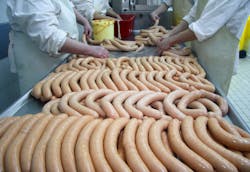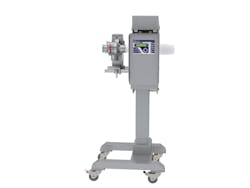COVID-19: Keeping food processing allergen risks in check
Data is still being gathered and analyzed about the link between allergies and COVID-19, including the severity of symptoms. Despite media reports to the contrary, Dr. Tom Casale, Chief Medical Advisor for Operations of Food Allergy Research & Education (FARE), reassures that even patients with asthma, classed by some as a higher risk group, are not at increased risk for having any more problems from the infection than the normal population.
Yet, with so many unknowns, the current pandemic does provide food processors with an opportunity to review their entire cross contamination and sanitation policies,.
Although there is currently no evidence that the novel coronavirus can be transmitted via food, transmission via surfaces recently contaminated with viruses is, nonetheless, possible through smear infections. In fact, The New England Journal of Medicine now suggests that the COVID-19 virus can survive a few hours on contact surfaces or objects. Making a vigorous enforcement of good hygiene, sanitation and Good Manufacturing Practices (GMPs) vital in all food production areas. By taking steps to mitigate all cross contamination and physical risks, manufacturers can allay a wide range of consumer fears.
Maintaining allergen controls
Data confirms that the challenges around allergies in North America are real and on the rise. Currently, an estimated 32 million Americans have food allergies, or nearly 10 % of the population — 10 times the prevalence reported 35 years ago — according to foodallergy.org. The severity of symptoms seems to be increasing, too.
About 90% of allergic reactions come from eight foods. Studies published in 2018 and 2019 suggest that crustacean shellfish is the food that most are allergic to, followed by milk and peanuts. Tree nuts, egg, wheat, soy, fin fish make up the remaining food types. Allergy to sesame is an emerging concern.
While severe, life-threatening food-related allergic reactions are still relatively uncommon, studies suggest that more than 200,000 make a trip to the emergency room as a result of food allergies. That’s approximately someone every 2.5 minutes, and according to FARE medical procedures to treat anaphylaxis resulting from food allergy increased by 380% between 2007 and 2016.
The number of ER admissions is worrying. These figures demonstrate the importance of continuing to raise awareness of severe allergies and the need to create a safe environment for all people with allergies through wider research and education programs.
Doubling up hygiene efforts
For the food and drink supply chain, reducing the risk of consumer exposure to allergens starts with the greatest care being taken in the sourcing all ingredients, auditing suppliers and so on. But the benefits of carefully managing allergen content can be reversed at the factory stage by cross-contact contamination. The risks here are especially acute given that only tiny amounts of an allergen can trigger a serious reaction in a sufferer. For this reason, larger manufacturers will, where possible, segregate production areas handling known allergens, such as nuts and seafood.
For smaller manufacturers, this option may not be available. In this case, the emphasis must again fall on hygiene and good process practices. In fact, where potential allergens are present, or could be present, in some sets of ingredients but not in others, cleaning must go well beyond normal hygienic requirements. Even where heat processing is involved, allergens can still survive high temperatures.
Re-emphasizing the importance of staying safe, Fortress President Steve Gidman comments: “These are unprecedented times for our food supply chains. The current COVID-19 pandemic has placed greater emphasis on sanitation and best practice in food factories. Taking preventative measures when it comes to cross contamination of any kind and re-doubling hygiene and sanitation efforts will always help to combat the risk of allergen, pathogen or bacteria contamination.”
The latest FDA advice confirms that cleaning routines on frequently touched surfaces, including workstations, countertops, doors and equipment, should be maintained using EPA-registered “sanitizer” products in their cleaning and sanitizing practices. Additionally, there is now a list of EPA-registered “disinfectant” products specifically meeting the criteria SARS-CoV-2, the virus that causes COVID-19 (https://www.epa.gov/pesticide-registration/list-n-disinfectants-use-against-sars-cov-2). The same precautions for factory operatives that have symptoms like fevers and acute respiratory illness should be observed.
While not an exhaustive checklist, the following areas of advice from Fortress provide a good starting point, in particular when it comes to the overlap between allergen control and metal detection:
- Equipment cleaning protocols: These should be formalized and included in staff training. Every cleaning process needs to be verified and documented. As part of a validation process, regular tests, including swabs of Critical Control Points, should be scheduled to ensure these areas are allergen-free.
- In-process metal detection: Priorities and hazard analysis will be different for every plant, but many manufacturers will want to screen their different ingredient streams, liquid and solid, for contaminants rather than relying on end-of-line conveyor-based metal detection for packaged product. Where ingredients have been assessed as higher risk, it makes sense to screen them at an upstream point in the process. The costs associated with ejecting contaminated product at the far end of the processing and packing operation are likely to be appreciably higher.
- Powders and liquids: Product residues, potentially including allergens, can be especially troublesome in gravity metal detection systems for powders and particulates. But liquids, semi-liquids and slurries in pipeline systems can pose problems of their own. Hygiene processes must be thorough in both settings.
- Overall system design: Efficient product changeovers are critical to productivity. For food processing managers facing regular changeovers of this sort, especially where allergen control is a priority, it is essential for processing, filling and packing lines to be designed to facilitate both quick and deep cleaning.
- Metal detection system design: When specifying in-process metal detection, contact surfaces on conveyor, pipeline and gravity systems should be as smooth and crevice-free as possible. This is partly to ensure that no traces of product, allergens or bacteria are left, but also to reduce the risk of cleaning agents not being fully rinsed away.
- High-pressure cleaning. High-pressure cleaning may well be deployed for fast, effective washdown, and the casing of the metal detector should be sufficiently robust to withstand this. When selecting a system, care should be taken to identify equipment with an ingress protection (IP) rating appropriate to the washdown regime being applied.
- Reject mechanism: Special attention should be paid to the reject unit. Ideally, this will be detachable (easily detached, but quickly and securely reattached, too) to allow thorough cleaning.
- Other sources of risk: Of course, there are many other potential sources of cross-contamination in a food and drink factory. The potential role of operators in spreading allergens by moving ingredients around the floor in unsealed containers, running allergenic products at the start of the shift rather than the end, not changing or cleaning protective equipment, for example, needs to be driven home where the risks are especially high.
To directly address the requirement for thorough, verifiable and efficient cleaning in factories to combat the risk of contamination, the Meat Pump Pipeline System from Fortress makes it easier for sanitation employees to roll out, dismantle and clean to prevent bacteria accumulations. Features a product tube that is fabricated from a solid piece of food grade Delrin, which is free from cervices that traditional tubes have due to the three-piece construction.
Similarly, the company’s newest Gravity Metal Detector features an optional quick release “roll out” reject unit that fully supported when rolled out of product flow position for cleaning. A drastic improvement on the traditional use of clean out ports that can still be cumbersome for cleanout, and mechanically weaken the valve body. Designed to inspect freefalling products in dry, granular and bulk form, food processing operatives can quickly disconnect, gain access to working parts, clean and slot back into place, helping to prevent high risk air borne allergens, for example nut dust, lactose or cereals containing gluten, building up in and around the Gravity unit.
With the outbreak of COVID-19 disrupting the availability of labor in many food processing sites, ensuring the continued supply of food, especially fresh and ambient produce, requires that special attention be given to ensuring agency staff understand the importance of allergen and cross contamination procedures.
Purchasing the best metal detection equipment for the job that incorporates the latest sanitary design principles may constitute only one portion of a much bigger picture for a complex food business with multiple product lines. Yet, it provides evidence that your company is taking the threat of contamination from allergens and pathogens seriously and will make a real and valuable contribution to reducing those risks.

